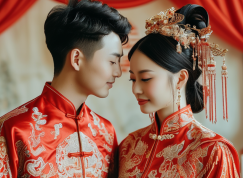
Chinese weddings are full of interesting customs and traditions. Let’s explore some fascinating facts about them.
The Three Letters and Six Etiquettes (礼仪)
After matchmaking, the proposal is confirmed with a formal letter of betrothal (订婚), which is the first of three letters. This letter outlines the couple’s intention to marry and their vows.
Next comes the gift letter, detailing the expected gifts. The final letter is the wedding letter, officially welcoming the bride into the groom’s family.
The “six etiquettes” include proposing, matching birthdates, exchanging betrothal gifts, giving wedding gifts, choosing the wedding date, and the ceremony itself.
A fortune-teller matches the couple’s birthdates to predict the success of their marriage.
The Wedding Tea Ceremony
Despite modern influences, the Chinese wedding tea ceremony remains a crucial part of the celebration. Tea is an important part of Chinese culture and traditionally included in a bride’s dowry (嫁妆).
Typically the ceremony is held at the couple’s respective homes on the wedding day, but some couples have the ceremony for both families before the wedding dinner. During the ceremony, the couple serves tea to elders in order of seniority, starting with the oldest and ending with the youngest. It is important for the couple to serve their paternal relatives before their maternal ones.
For more details on this unique custom, click here: Chinese Wedding Tea Ceremony.
Joining of Hair
In traditional Chinese culture, one’s hair represents one’s self. At a traditional Chinese wedding, the bride and groom cut a lock of their hair, tie it in a knot, and place it in a bag. This small ritual signifies their union and future happiness together.
原创编写 版权所有 侵权必究! 每日更新 个性化阅读 英语飙升!
1.1.A proposal is included in ________.
A the gift letter
B the last letter
C the letter of betrothal
D the wedding letter
解析:选C。C 细节理解题。根据第二部分中的“the proposal is confirmed with a formal letter of betrothal”可知,聘书是订亲之文书。在纳吉(男女订立婚约)时,男家交予女家之书柬。故选C。
2.2.Which of the following is NOT a part of the “six etiquettes” in a Chinese wedding?
A Exchanging gifts.
B Writing a wedding song.
C Birthday matching.
D The wedding ceremony.
解析:选B。B 细节理解题。根据第二部分中的“The ‘six etiquettes’ include proposing, matching birthdates, exchanging betrothal gifts, giving wedding gifts, choosing the wedding date, and the ceremony itself.”可知,六礼包括纳采、问名、纳吉、纳征、请期、亲迎。并未提及作曲。故选B。
3.3.During the Chinese wedding tea ceremony, who do the couple serve tea to first?
A The bride’s father.
B The groom’s father.
C The eldest family member.
D The wedding guests.
解析:选C。C 细节理解题。根据第三部分中的“During the ceremony, the couple serves tea to elders in order of seniority, starting with the oldest and ending with the youngest.”可知,婚礼上向长辈敬茶,应从最年长的开始,到最年轻的结束。故选C。
4.4.What does joining hair symbolize in a traditional Chinese wedding?
A The end of the wedding.
B Living happily together.
C Being ready for a new life.
D The bride’s control of life.
解析:选B。B 细节理解题,根据最后一段中的“This small ritual signifies their union and future happiness together.”可知,“结发”象征着夫妻间的深厚情谊和永恒的结合。故选B。
